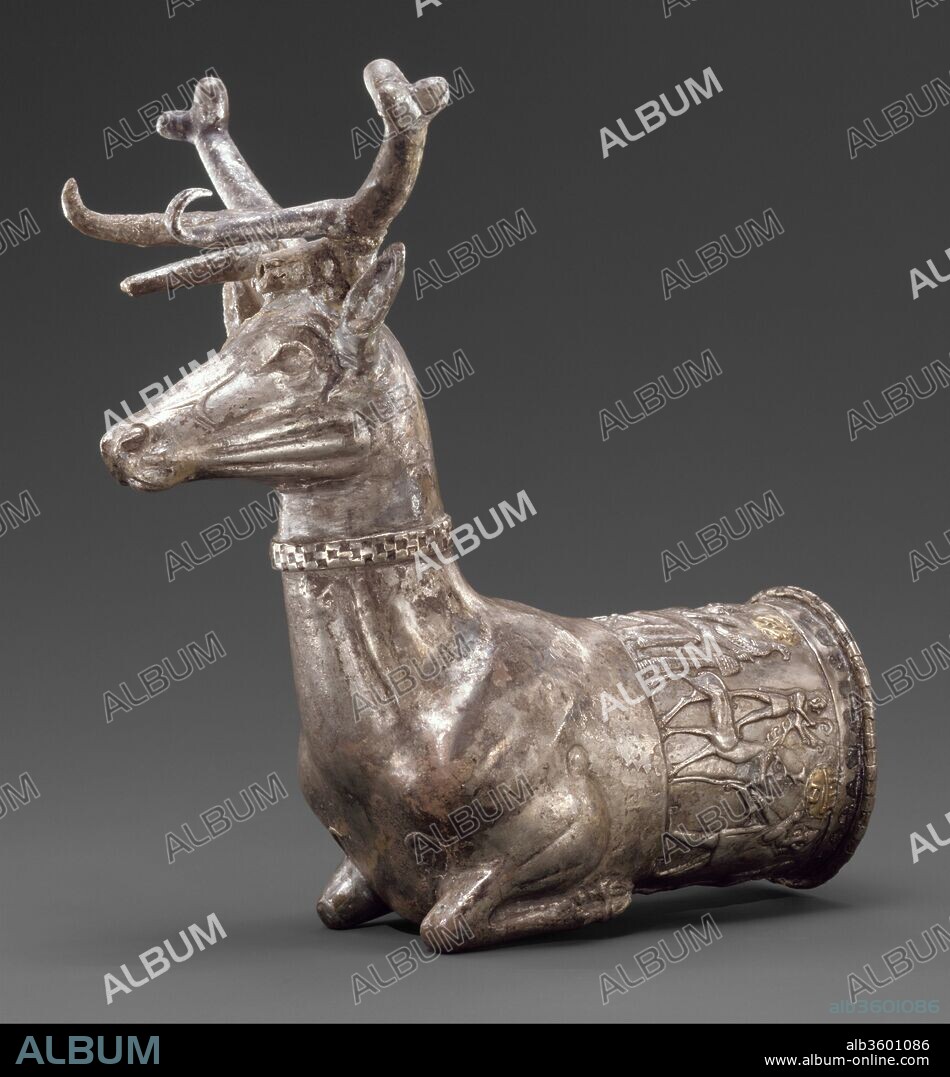alb3601086
Vessel terminating in the forepart of a stag

|
Añadir a otro lightbox |
|
Añadir a otro lightbox |



¿Ya tienes cuenta? Iniciar sesión
¿No tienes cuenta? Regístrate
Compra esta imagen

Título:
Vessel terminating in the forepart of a stag
Descripción:
Traducción automática: Vasija que termina en la parte delantera de un ciervo. Cultura: hitita. Dimensiones: H. 18 cm. Fecha: ca. Siglo XIV-XIII a.C. Para el año 1700 a. C., las personas que hablaban hitita, un idioma indoeuropeo, habían fundado una capital en Bogazköy (antigua Hattusha) y, bajo una serie de reyes poderosos, establecieron un estado en Anatolia central. El ejército hitita atacó y destruyó parcialmente a Babilonia en 1595 a. C. y en 1285 a. C. libró una batalla contra el rey egipcio Ramsés II en Qadesh en Siria. Este rhyton plateado, un recipiente para beber en forma de animal con un orificio para verter en el pecho, en forma de ciervo, fue martillado en una sola pieza que estaba unida a la cabeza por un anillo con diseño de tablero de ajedrez. Tanto los cuernos como el mango se unieron por separado. Un friso que representa una ceremonia religiosa decora el borde de la copa, sugiriendo los usos para los que estaba destinada la copa. Una figura prominente, que se cree que es una diosa, está sentada en un taburete con las piernas cruzadas, sosteniendo un ave de rapiña en la mano izquierda y una pequeña copa en la derecha. Lleva una corona cónica y tiene orejas grandes, típicas del arte hitita. Un quemador de incienso en forma de hongo la separa de un dios masculino que está de pie sobre el lomo de un ciervo. Él también sostiene un halcón en su mano izquierda, mientras que con la derecha agarra un pequeño bastón curvo. Se muestran tres hombres de perfil, moviéndose hacia la izquierda y frente a las deidades. Cada uno tiene una ofrenda a las divinidades. Detrás de los hombres hay un árbol o una planta contra la que descansa la figura derrumbada de un ciervo. Del árbol cuelga un carcaj con flechas y un objeto que parece ser una bolsa. Dos lanzas verticales completan el friso y separan al ciervo de la diosa. Las escenas de culto o las procesiones religiosas se representan comúnmente en el arte del Imperio hitita, y los textos hacen referencia frecuente a árboles y plantas asociados con rituales o festivales. Los textos también nos cuentan que las lanzas eran objetos venerados, por lo que es posible que el ciervo muerto en la caza, como sugieren la aljaba y la bolsa, estuviera dedicado al dios ciervo. Los textos hititas también mencionan que las vasijas con forma de animales hechas de oro, plata, piedra y madera, en la forma animal apropiada, fueron entregadas a los dioses para su propio uso. Aunque el significado preciso del friso de esta vasija sigue siendo objeto de conjeturas, es posible que fuera propiedad personal del dios ciervo.
Vessel terminating in the forepart of a stag. Culture: Hittite. Dimensions: H. 18 cm. Date: ca. 14th-13th century B.C..
By 1700 B.C., people speaking Hittite--an Indo-European language--had founded a capital at Bogazköy (ancient Hattusha) and, under a series of powerful kings, established a state in central Anatolia. The Hittite army attacked and partly destroyed Babylon in 1595 B.C., and in 1285 B.C. fought a battle against the Egyptian king Ramesses II at Qadesh in Syria.
This silver rhyton--a drinking vessel in the form of an animal with a pouring hole in its chest--in the form of a stag was hammered from one piece that was joined to the head by a checkerboard-patterned ring. Both the horns and the handle were attached separately. A frieze depicting a religious ceremony decorates the rim of the cup, suggesting the uses for which the cup was intended. A prominent figure, thought to be a goddess, sits on a cross-legged stool, holding a bird of prey in her left hand and a small cup in her right. She wears a conical crown and has large ears, typical of Hittite art. A mushroom-shaped incense burner separates her from a male god who stands on the back of a stag. He, too, holds a falcon in his left hand, while with his right he grasps a small curved staff. Three men are shown in profile, moving to the left and facing the deities. Each holds an offering to the divinities. Behind the men is a tree or plant against which rests the collapsed figure of a stag. Hanging from the tree is a quiver with arrows and an object that appears to be a bag. Two vertical spears complete the frieze and separate the stag from the goddess.
Cult scenes or religious processions are commonly represented in the art of the Hittite Empire, and texts make frequent reference to trees and plants associated with rituals or festivals. The texts also tell us that spears were venerated objects, so it is possible that the stag, killed in hunt, as is suggested by the quiver and bag, was being dedicated to the stag god. Hittite texts also mention that animal-shaped vessels made of gold, silver, stone, and wood, in the appropriate animal form, were given to the gods for their own use. Though the precise meaning of the frieze on this vessel remains a matter of conjecture, it is possible that it was intended to be the personal property of the stag god.
Técnica/material:
Silver, gold inlay
Periodo:
Hittite Empire
Museo:
Metropolitan Museum of Art, New York, USA
Crédito:
Album / Metropolitan Museum of Art, NY
Autorizaciones:
Modelo: No - Propiedad: No
¿Preguntas relacionadas con los derechos?
¿Preguntas relacionadas con los derechos?
Tamaño imagen:
3585 x 3865 px | 39.6 MB
Tamaño impresión:
30.4 x 32.7 cm | 11.9 x 12.9 in (300 dpi)
Palabras clave:
 Pinterest
Pinterest Twitter
Twitter Facebook
Facebook Copiar enlace
Copiar enlace Email
Email
